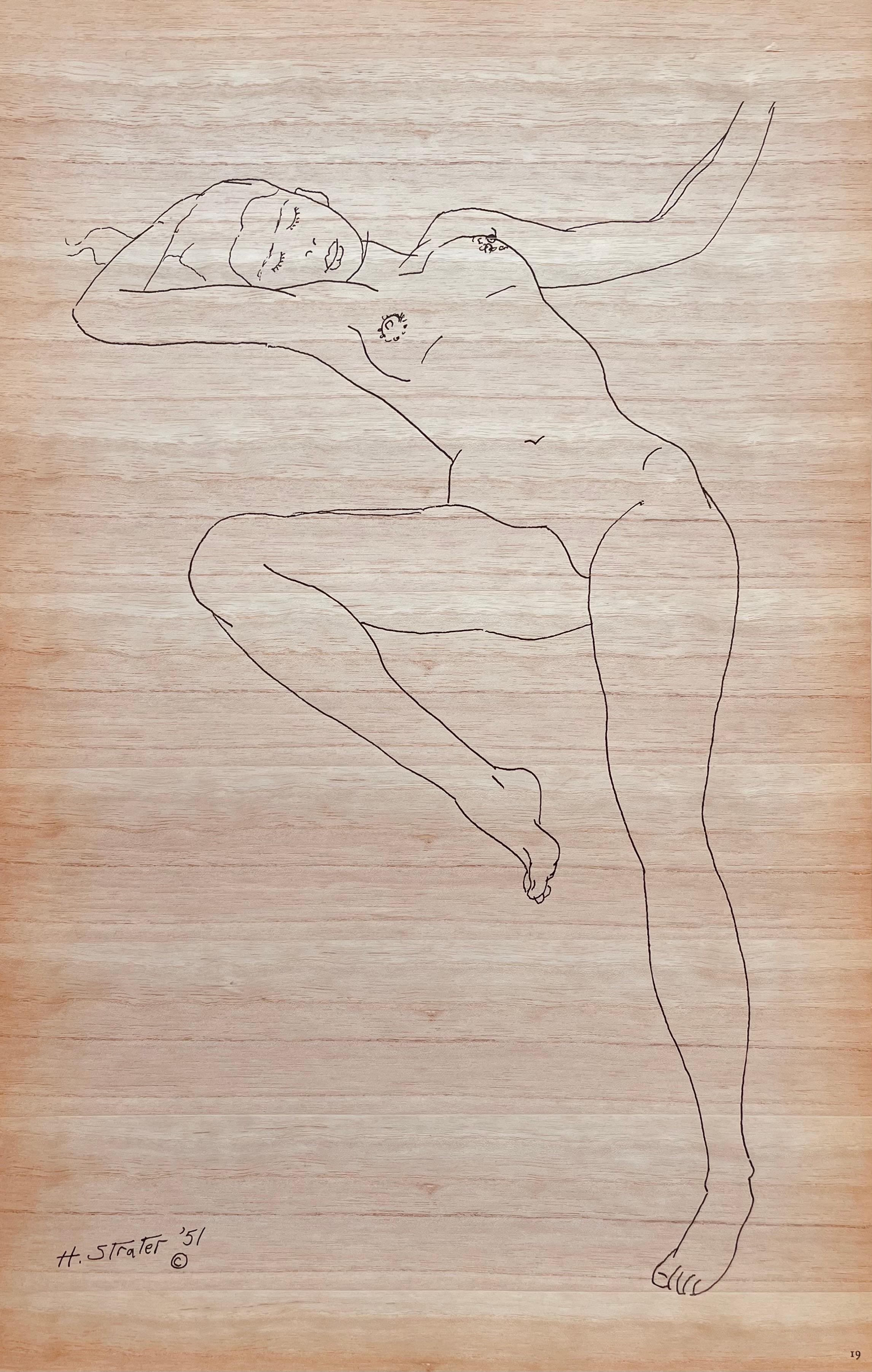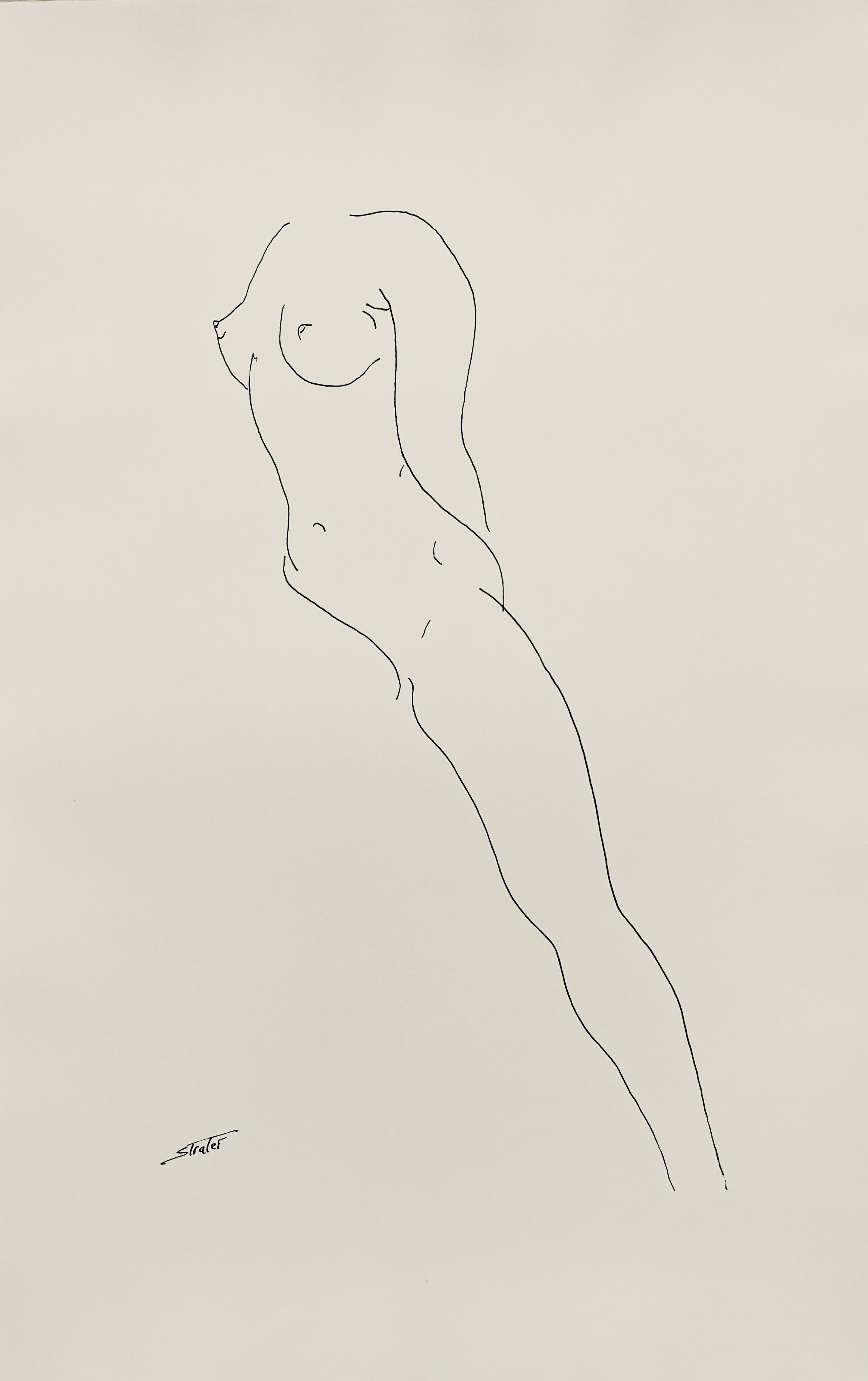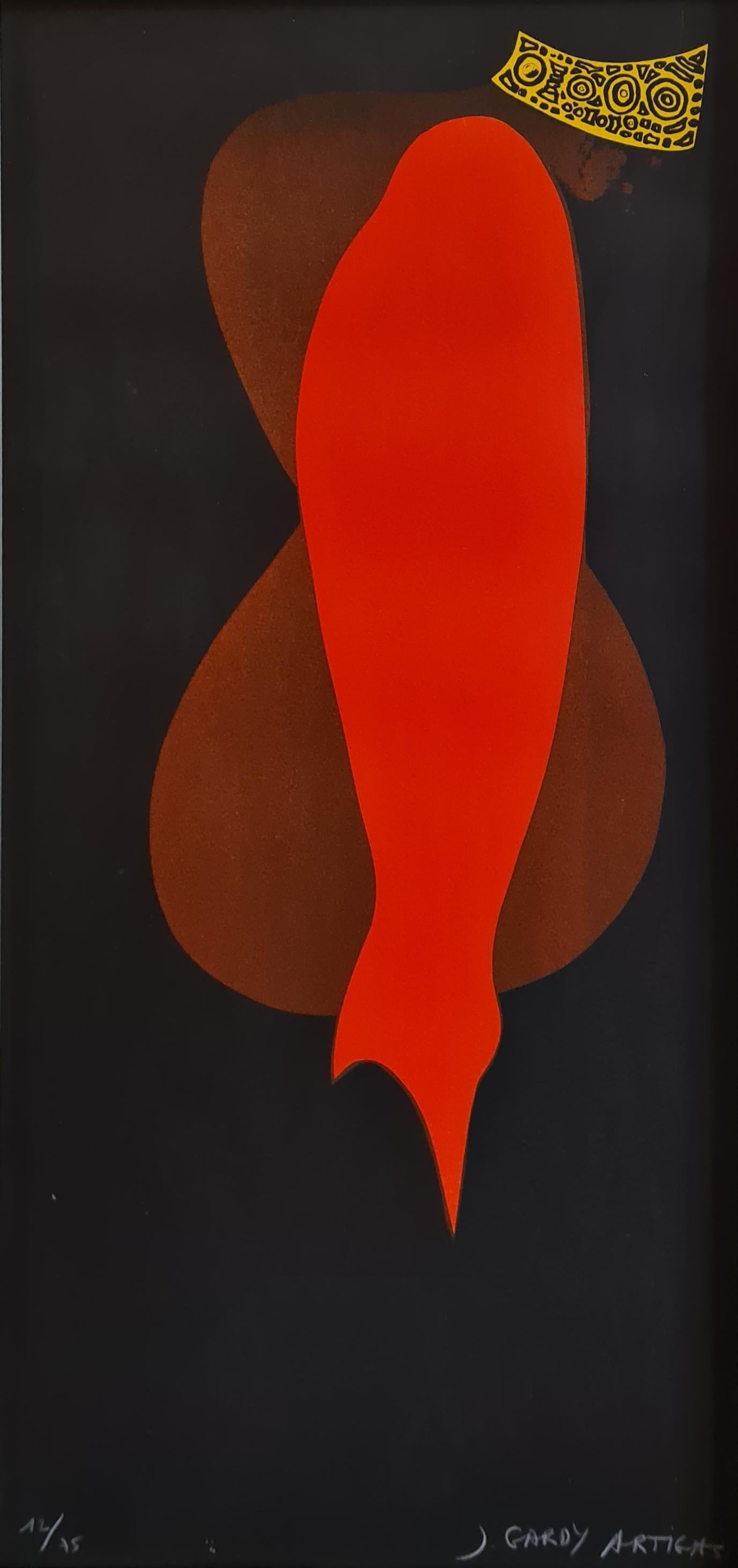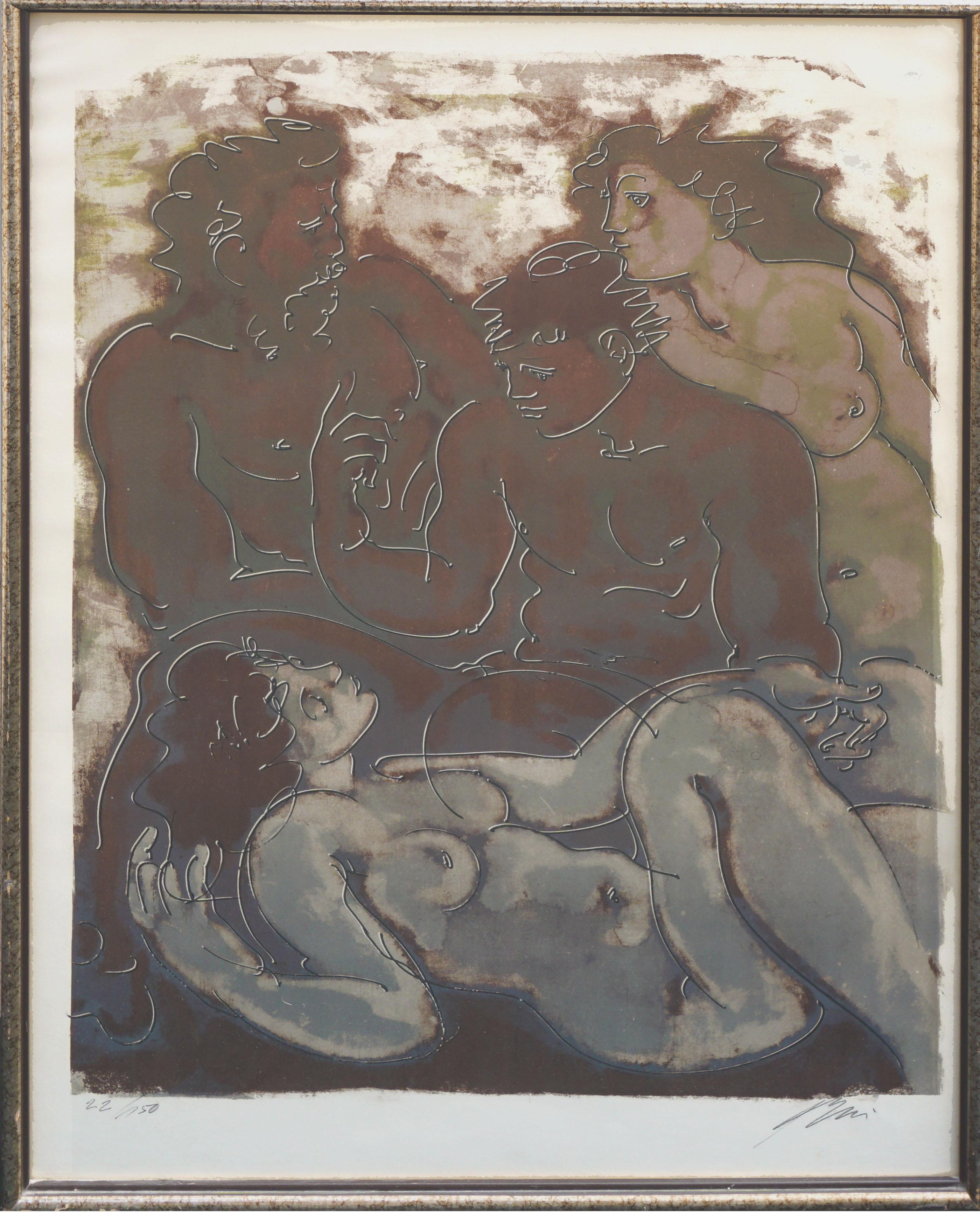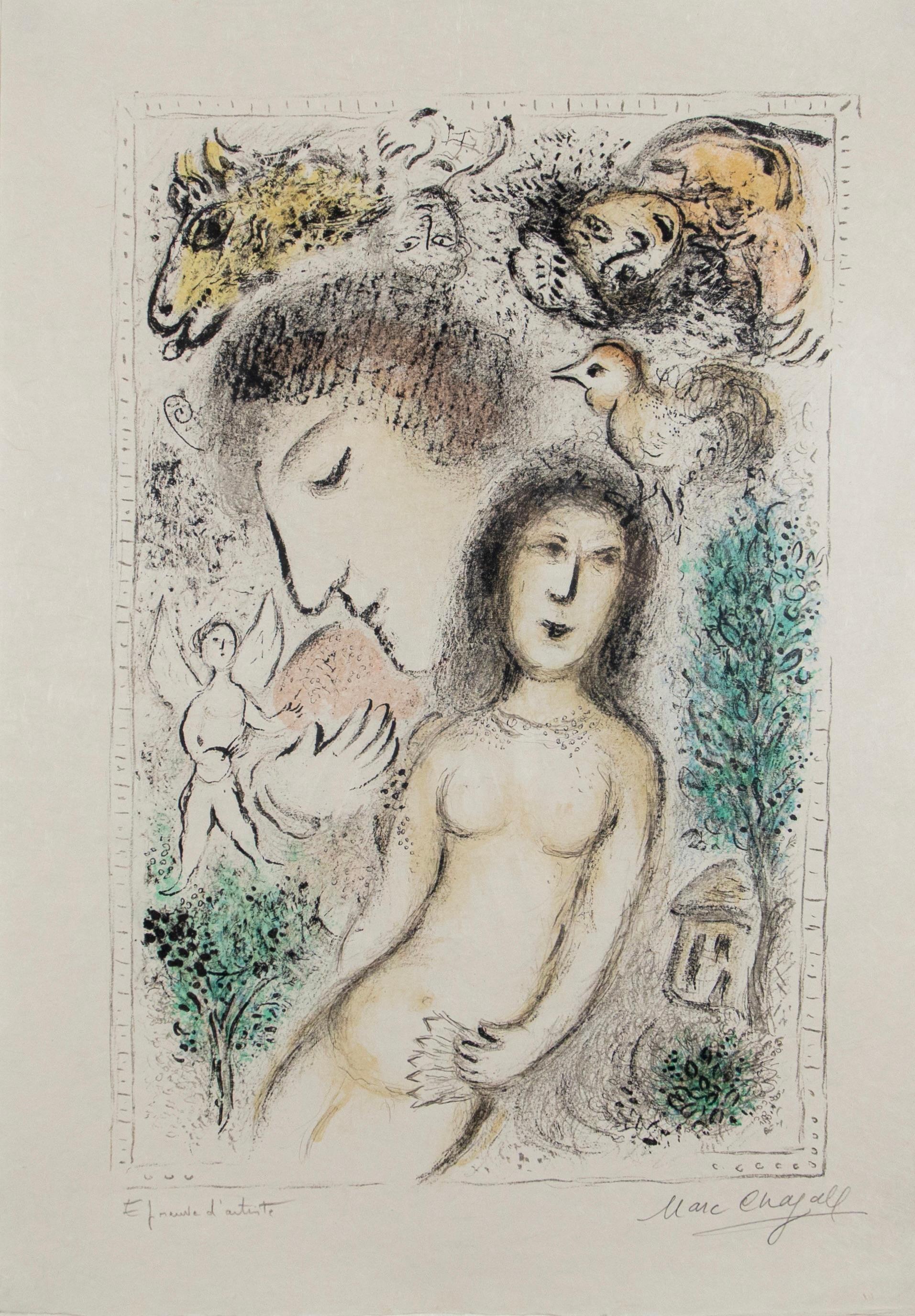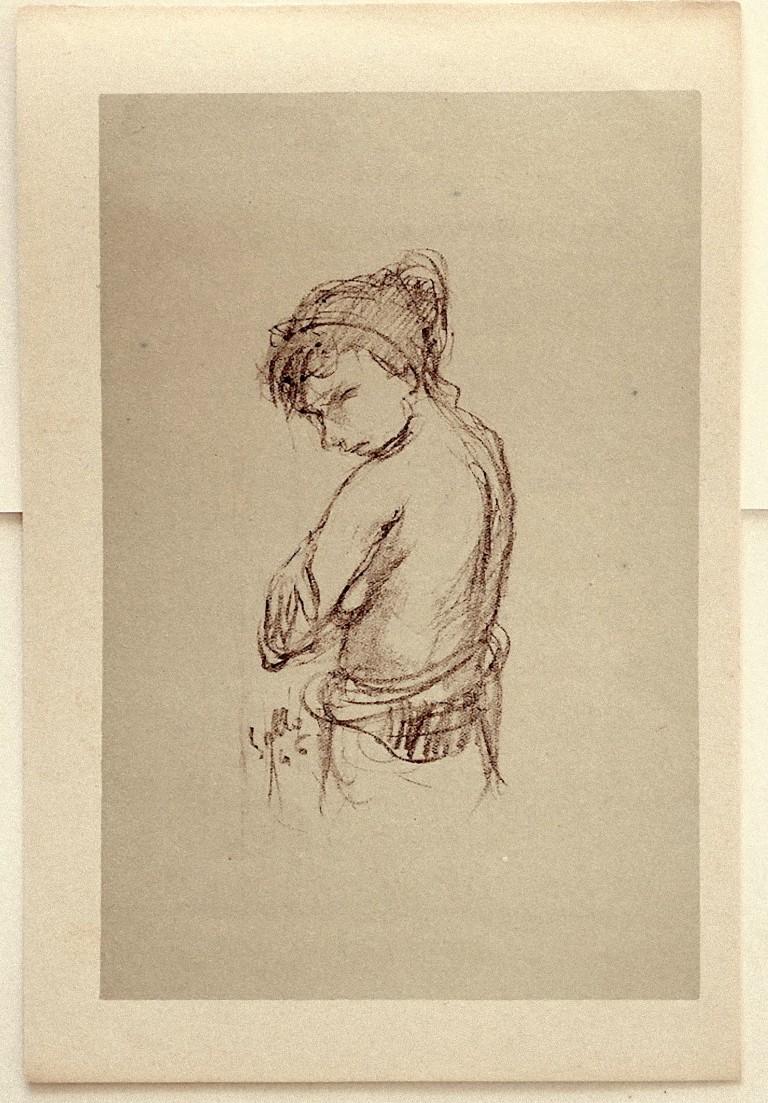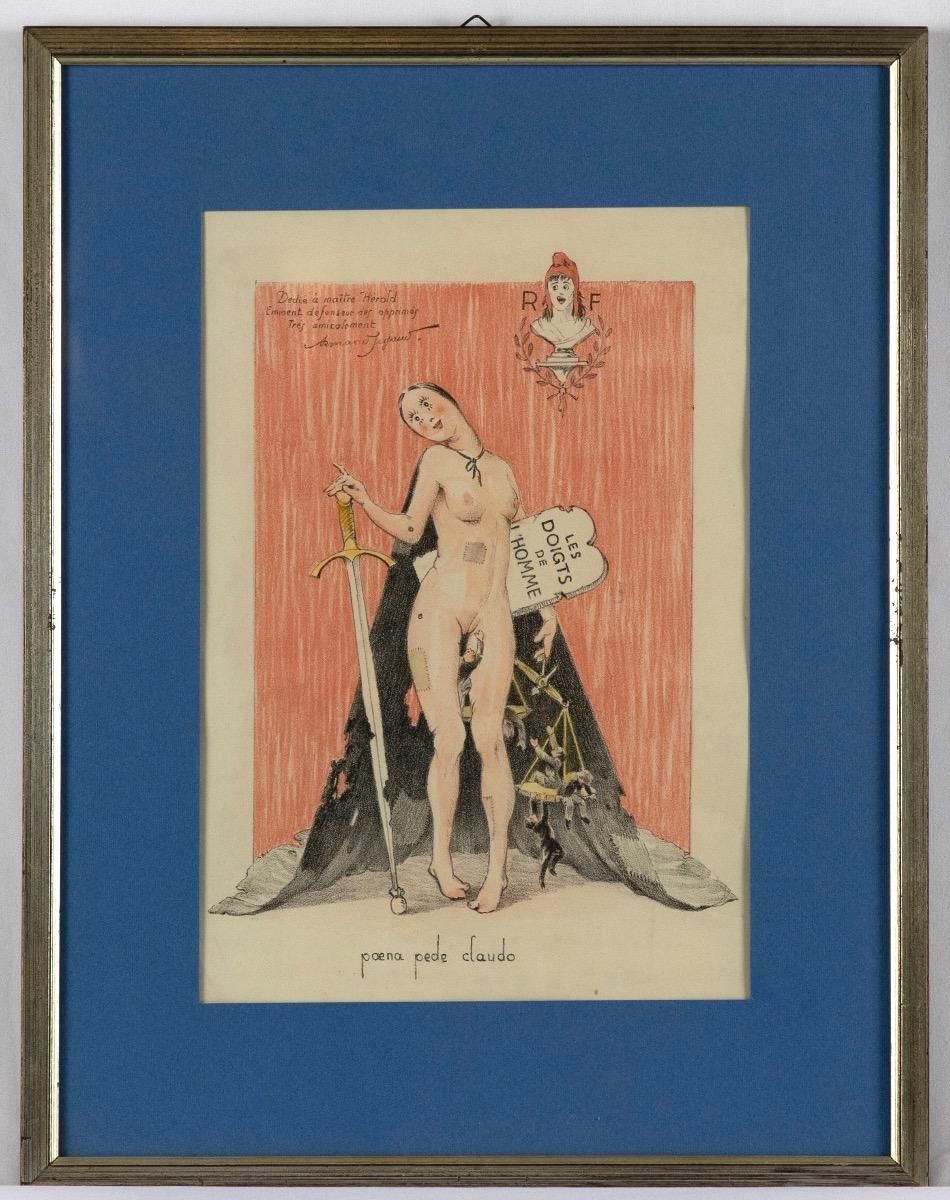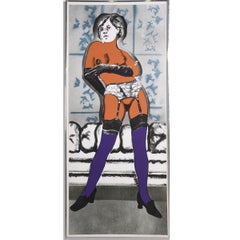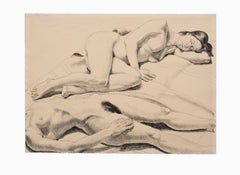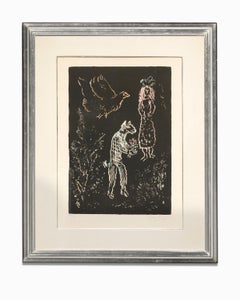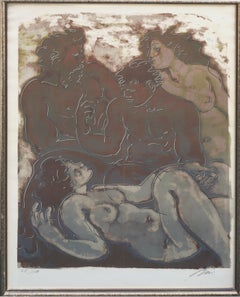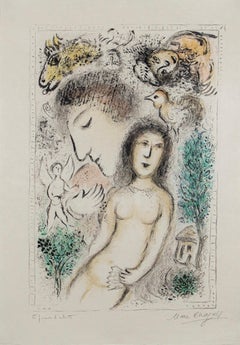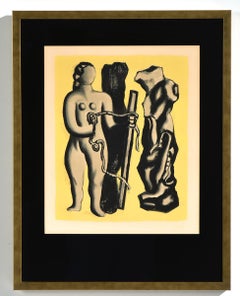
"Femme sur fond juane" Abstract Lithograph with Colors and Nude Female
View Similar Items
Fernand Léger"Femme sur fond juane" Abstract Lithograph with Colors and Nude Female1952
1952
About the Item
- Creator:Fernand Léger (1881-1955, French)
- Creation Year:1952
- Dimensions:Height: 27.5 in (69.85 cm)Width: 21.5 in (54.61 cm)
- Medium:
- Movement & Style:
- Period:
- Condition:
- Gallery Location:Detroit, MI
- Reference Number:1stDibs: LU128615597812
Fernand Léger
A painter as well as a filmmaker, illustrator, stage-set designer, ceramicist and printmaker, Fernand Léger was one of the most prolific artists of the first half of the 20th century. His early mature work as a Cubist was marked by the use of bold colors and contrasts and a visual vocabulary inspired by industrial technology. In his later career, Léger turned to idiomatic, almost naïve depictions of human figures, in a belief that his work should be accessible to ordinary people and relevant to their lives.
Born in Normandy, the son of a cattle trader, Léger worked as an architectural draftsman in Paris while studying art. By 1908 he was a member of an artistic circle that included Marc Chagall, Robert Delaunay, sculptor Jacques Lipchitz, and the poet Guillaume Appolinaire, and through them he became connected to the Cubists. As opposed to the flat planes and neutral hues seen in the paintings of Pablo Picasso and Georges Braque, Léger’s Cubist abstractions were devised with vivid colors and forms that had dimensionality. Soon after his army service in World War I — he was gassed at the Battle of Verdun — Léger entered his “mechanical” period. Convinced that technology would improve the human condition, he painted compositions of tubular shapes and cylinders that are reminiscent of machine parts. In other work, Léger sought to capture the bustle and brio of modern life with references to railroad stations, factories, street signs and billboards.
Léger had also emerged from the trenches with a deep concern to make his art engage the sorts of men and women he had met during the war. He sought to bring his work to a wider audience through film, theater sets and book illustrations. In the 1920s, influenced by Purism — a variant on Cubism that promoted a simpler and more direct approach to forms and compositions — Léger produced a series of paintings depicting everyday objects: a soda siphon, an accordion, a guitar and vase. The human figure returned to his work. By 1930, pure abstraction disappeared almost completely from Léger’s art in favor of simple studies of people. Their boldly outlined forms, placed against a bright background, can be regarded as an assemblage of parts — yet in these representations of dancers, acrobats and folks on bicycles, Léger seems to be articulating a kind of kinship and affection. You will see from the works on offer why Fernand Léger is often regarded as the warmest and most humane of the great modern artists.
Find a collection of original Fernand Léger art today on 1stDibs.
- Larry Rivers Lithograph "For Adults Only I" Corseted Nude FemaleBy Larry RiversLocated in Detroit, MISALE ONE WEEK ONLY "For Adults Only I" is an exquisite offset lithograph print with colors of an alluring corseted and stockinged nude female in a confrontational pose filling the f...Category
1970s Pop Art Figurative Prints
MaterialsLithograph, Offset
$3,900 Sale Price40% Off - "Two Reclining Nudes" Lithograph on Paper, Figurative, Female NudesBy Philip PearlsteinLocated in Detroit, MI"Two Reclining Nudes" is an exceptional Lithograph of Pearlstein's Realistic style. The nudes are posed reclining, neither engaged with either each other or the viewer, and give the atmosphere of being in a dream state. It is an intimate scene without intimacy. Their full-figured bodies exude power and strength which is reinforced by not fitting within the frame. This Lithograph is #42 of an edition of 100 with one blind stamp, and signed by the artist all located in the upper left corner. Philip Pearlstein is an American painter born in Pittsburgh, PA, and best known for Modernist Realism nudes. Cited by critics as the preeminent figure painter of the 1960s to 2000s, he led a revival in realist art. He is a Distinguished Professor Emeritus with paintings in the collections of over 70 public art museums. In 1941, his junior year in high school, he received his first recognition when awarded first and third prizes in Scholastic Magazine’s 14th National High School Art Exhibition. Upon graduation from high school in 1942, he enrolled in the Carnegie Institute of Technology but the draft limited his attendance to one year. After discharge from the army in 1946, he returned to Carnegie Tech where he received his BFA in 1949. Upon graduation, he moved to New York City where he pursued work in graphic design and received a Master’s degree in art history from New York University in 1955. Pearlstein worked as a graphic designer for Life Magazine before becoming an instructor at the Pratt Institute, and then a professor at Brooklyn College; he has also served as a visiting artist at several prestigious institutions throughout the country. His work has been exhibited in several solo exhibitions throughout the United States with paintings in the collections of over 70 public art museums. Pearlstein served as a President of the American Academy of Arts and Letters from 2003-2006 and currently lives and works in New York. “It is what is painted between the outlines that makes the difference between merely competent painting and really meaningful art.” —Philip Pearlstein In spring of 1946 he becomes assistant to Robert Lepper, head of the Design Program at Carnegie Institute of Technology, at the firm of Altenhof and Bown, Architects, and designs catalogs for building products through 1949. Meanwhile he enrolled at Carnegie Institute of Technology and studied with Robert Lepper, Balcomb Green, and Samuel Rosenberg. Meets Dorothy Cantor, George Klauber, and Andy Warhol (Warhola), fellow students at Carnegie Institute of Technology. Serves as art editor of the Carnegie Technical, the student publication of the Engineering School, through 1949 when he received his BFA and moved to New York to live with Andy Warhol. A few months later he worked with graphic designer Ladislav Sutnar in design and production of catalogs of plumbing fixtures and ventilators for the next eight years. He graduated from the Institute of Fine Arts, New York University where he studied with Karl Lehmann, Craig Smith and Jose Lopez-Rey. In 1954 Clement Greenberg selectd Pearlstein to be in “Emerging Talent” show at Kootz Gallery, New York. Torso is shown. Show includes Herman Cherry, Paul Freeley, Paul Georges, Cornelia Langer, Saul Leiter, Morris Louis, Anthony Louvis, Sue Mitchell, Kenneth Noland, and Theophil Groell. He received his M.A. in Art History from Institute of Fine Arts, New York University. His thesis on Francis Picabia with Jose Lopez-Rey and H.W. Janson as advisors. In September of 1958 he received a Fulbright Grant for Painting in Italy and traveled to Rome, Florence, Venice, Amalfi Coast and Sicily. Back in New York his drawing group includes at various times during the following thirteen years: Ann Arnold, Rudolph Burkhardt, Charles Cajori, Gretna Campbell, Lois Dodd, Louis Finkelstein, Joe Fiore, Sideo and Nora Fromboluti, Mary Frank, Stephen Greene, Theophil Groell (Repke), Philip Guston, Yvonne Jacquette, Diana Kurtz, Alex Katz, Gabriel Laberman, Mercedes Matter, George McNeil, Sidney Tillim, Jack Tworkov and William White. Meets initially in Mercedes Matter’s studio. Continues to meet with group at various locations, including his own studio through 1972. In 1969 and 1971 he received the John Simon Guggenheim Memorial Foundation grant. In 1982 he served as the Artist in Residence at the American Academy of Art, Rome. In addition to other numerous awards and honors he received an Honorary Doctorate Degree from the Center for Creative Studies and the College of Art & Design, Detroit, Michigan in 2000. Other known CCS faculty and graduates are Susan Aaron-Taylor, Richard Jerzy, Harry Bertoia, Doug Chaing, Stephen Dinehart, Tyree Guyton, Renee Radell, Herb Babcock, Jerome Ferretti...Category
1970s Contemporary Nude Prints
MaterialsLithograph
$1,400 Sale Price20% Off - "Nuit d'été (Summer's Night)" Lithograph, Colors, Linear Figures on Black GroundBy Marc ChagallLocated in Detroit, MISALE ONE WEEK ONLY Marc Chagall is clearly a Modernist. Though titled "Summer Night" it could just as easily be identified as a scene from Shakespeare...Category
Late 20th Century Modern Figurative Prints
MaterialsRag Paper, Lithograph
- Arnold Singer "Woman on Arm of Sofa" Lithograph Linear Black & WhiteLocated in Detroit, MI“Woman on Arm of Sofa” is an extraordinary lithograph by Arnold Singer. You could say it is representative of his interests in several art styles that ar...Category
1960s Contemporary Figurative Prints
MaterialsLithograph
$1,000 Sale Price20% Off - Roy Lichtenstein Tryptich "as I opened fire" 1966 Stedelijk Museum AmsterdBy Roy LichtensteinLocated in Detroit, MISALE ONE WEEK ONLY "As I opened fire" is a lithograph triptych by Roy Lichtenstein whose provenance is printed on verso: Coll. Stedelijk Museum Amsterdam. Editions were copyrighted by the Stedelijk Museum Amsterdam and corrected with the original and printed in the Netherlands. Each piece measures: 25 1/8" h x 20 5/8" w. Roy Fox Lichtenstein was an American pop artist. During the 1960s through the 90’s, along with Andy Warhol, Jasper Johns, and James Rosenquist, he became a leading figure in the new art movement. His work defined the premise of pop art through parody. Most of Lichtenstein's best-known works are relatively close, but not exact, copies of comic book panels, a subject he largely abandoned in 1965. Lichtenstein's Still Life paintings, sculptures and drawings, which span from 1972 through the early 1980s, cover a variety of motifs and themes, including the most traditional such as fruit, flowers, and vases. Inspired by the comic strip, Lichtenstein produced precise compositions that documented while they parodied, often in a tongue-in cheek manner. His work was influenced by popular advertising and the comic book style. His artwork was considered to be "disruptive". He described pop art as "not 'American' painting but actually industrial painting". His paintings were exhibited at the Leo Castelli Gallery in New York City. Wham!, and Drowning Girl Look Mickey proved to be his most influential works. His most expensive piece is Masterpiece which was sold for $165 million in January 2017. Lichtenstein received both his Bachelors and Masters at Ohio State University, Columbus, Ohio where he taught for ten years. In 1967, he moved back to upstate New York and began teaching again. It was at this time that he adopted the Abstract Expressionist style, being a late convert to this style of painting. Lichtenstein began teaching in upstate New York at the State University of New York at Oswego in 1958. About this time, he began to incorporate hidden images of cartoon characters such as Mickey Mouse and Bugs Bunny into is abstract works. In 1960, he started teaching atRutgers University where he was heavily influenced by Allan Kaprow, who was also a teacher at the university. This environment helped reignite his interest in Proto-pop imagery. In 1961, Lichtenstein began his first pop paintings using cartoon images and techniques derived from the appearance of commercial printing. This phase would continue to 1965, and included the use of advertising imagery suggesting consumerism and homemaking. His first work to feature the large-scale use of hard-edged figures and Ben-Day dots was Look Mickey (1961), National Gallery of Art, Washington, D. C.) This piece came from a challenge from one of his sons, who pointed to a Mickey Mouse comic book and said; "I bet you can't paint as good as that, eh, Dad?" In the same year he produced six other works with recognizable characters from gum wrappers and cartoons. It was at this time that Lichtenstein began to find fame not just in America but worldwide. He moved back to New York to be at the center of the art scene in 1964 to concentrate on his painting. Lichtenstein used oil and Magna (early acrylic) paint in his best known works, such as Drowning Girl (1963), which was appropriated from the lead story in DC Comics’ Secret Hearts No. 83, drawn by Tony Abruzzo. (Drowning Girl now hangs in the Museum of Modern Art, New York.) Drowning Girl also features thick outlines, bold colors and Ben-Day dots, as if created by photographic reproduction. Of his own work Lichtenstein would say that the Abstract Expressionists "put things down on the canvas and responded to what they had done, to the color positions and sizes. My style looks completely different, but the nature of putting down lines pretty much is the same; mine just don't come out looking calligraphic, like Pollock’s or Kline’s. Rather than attempt to reproduce his subjects, Lichtenstein's work tackled the way in which the mass media portrays them. He would never take himself too seriously, however, saying: "I think my work is different from comic strips – but I wouldn't call it transformation; I don't think that whatever is meant by it is important to art.” When Lichtenstein's work was first exhibited, many art critics of the time challenged its originality. His work was harshly criticized as vulgar and empty. The title of a Life magazine article in 1964 asked, "Is He the Worst Artist in the U.S.?" Lichtenstein responded to such claims by offering responses such as the following: "The closer my work is to the original, the more threatening and critical the content. However, my work is entirely transformed in that my purpose and perception are entirely different. I think my paintings are critically transformed, but it would be difficult to prove it by any rational line of argument.” In 1969, Lichtenstein was commissioned by Gunter Sachs to create Composition and Leda and the Swan, for the collector's Pop Art bedroom suite at the Palace Hotel in St. Moritz. In the late 1970s and during the 1980s, Lichtenstein received major commissions for works in public places: the sculptures Lamp (1978) in St. Mary's, Georgia; Mermaid (1979) in Miami Beach; the 26 feet tall Brushstrokes in Flight (1984, moved in 1998) at John Glenn Columbus International Airport; the five-storey high Mural with Blue Brushstroke (1984–85) at the Equitable Center, New York and El Cap de Barcelona (1992) in Barcelona. In 1994, Lichtenstein created the 53-foot-long, enamel-on-metal Times Square Mural in Times Square subway station. In 1977, he was commissioned by BMW to paint a Group 5 Racing Version of the BMW 320i for the third installment in the BMW Art Car Project. The DreamWorks Records logo was his last completed project. "I'm not in the business of doing anything like that (a corporate logo) and don't intend to do it again," allows Lichtenstein. "But I know Mo Ostin and David Geffen and it seemed interesting. In 1996 the The National Gallery of Art in Washington, D.C. became the largest single repository of the artist's work when Lichtenstein donated 154 prints and 2 books. The Art Institute of Chicago has several important works by Lichtenstein in its permanent collection, including Brushstroke with Spatter (1966) and Mirror No. 3 (Six Panels) (1971). The personal holdings of Lichtenstein's widow, Dorothy Lichtenstein, and of the Roy Lichtenstein Foundation number in the hundreds. In Europe, the Museum Ludwig in Cologne has one of the most comprehensive Lichtenstein holdings with Takka Takka (1962), Nurse (1964), Compositions I (1964), besides the Frankfurt Museum fur Modern Kunst with We Rose Up slowly (1964), and Yellow and Green Brushstrokes...Category
1960s Pop Art Figurative Prints
MaterialsLithograph
$1,500 Sale Price40% Off - "History of Detroit" Linoleum Cut, Black Ink, African American, Mural StyleBy Hubert MasseyLocated in Detroit, MI"History of Detroit" is in the style of a mural by the master muralist from the city of Detroit, Hubert Massey. It renders in dramatic composition the ov...Category
Early 2000s American Modern Figurative Prints
MaterialsLinocut
- 'Chamonix' Mid-Century Hand Signed Original Lithograph.By Joan Gardy ArtigasLocated in Cotignac, FRMid-Century original lithograph entitled " Chamonix " hand signed by Joan Gardy Artigas and numbered 12/75 on arches vellum rag paper from the 1966-70 edition. Presented in period 19...Category
Mid-20th Century Modern Figurative Prints
MaterialsPrinter's Ink, Rag Paper, Lithograph
- The Conversation, Greek Myth Figurative LithographBy Hans ErniLocated in Soquel, CAWonderful figurative lithograph of a group of four nude figures in sable brown and gray palette by Hans Erni (Swiss, 1909-2015) circa 1970s. Signed in pencil by artist lower right corner. #22/150 on lower left. Presented in platinum toned wood frame under glass. Image size: 31"H x 22.25"W. Framed size: 32"H x 23W x 1"D Hans Erni was born in 1909. Erni attended the Kunstgewerbeschule in Lucerne in 1927-28, which was followed by further stays in Paris and Berlin. In 1933-34 he joined the artist's group Abstraction-Création in Paris, where he also met artists like Hans Arp, Alexander Calder and Wassily Kandinsky. In the 1930-40s, he was very successful with fresco painting, a medium the artist deeply preferred because of its impact on society. In 1950 Erni created his first ceramic works and discovered lithography as another central technique of his future artistic output. In 1972 he set up his studio in Saint-Paul-de-Vence, but he continued to be active in Lucerne, where he was born and obtained personal museum spaces. Erni was awarded with numerous prizes, including the UN Peace Medal...Category
1970s Modern Figurative Prints
MaterialsPaper, Lithograph
- “Le Nu” The Nude - Color lithograph 1978 - Framed - Signed - angel, birdBy Marc ChagallLocated in Rancho Santa Fe, CAMarc Chagall "Le Nu" Lithograph in colors on Arches paper 21.25 x 14 in. (image size) 25.5 x 18.38 in (sheet size) Edition of 50 + Épreuve d'artiste Signed in pencil lower rig...Category
1970s Modern Figurative Prints
MaterialsArchival Paper, Lithograph
- Nude - Original Lithograph by Oscar Gallo - 1946Located in Roma, ITNude is an original lithograph on greenish paper realized in 1946 by the italian artist Oscar Gallo (1909 - 1994). Signed on the lower left and dated. The state of preservation is ...Category
1940s Modern Figurative Prints
MaterialsPaper, Lithograph
- Poena Pede Claudo - Lithograph by Maurice Neumont - Early 20th CenturyBy Maurice NeumontLocated in Roma, IT"Poena pede claudo" is an original print in lithograph on paper realized by Maurice Neumont( 1868-1930). Titled on the lower center. The state of preservation of the artwork is go...Category
Early 20th Century Modern Nude Prints
MaterialsPaper, Lithograph
- Nude Sculpture R.B. Kitaj drawing of nude woman on handmade orange paper printBy Ronald Brooks KitajLocated in New York, NYHere Kitaj depicts a sculpture of a nude woman, shaded delicately in black, printed on wonderfully textured handmade muted orange paper. The woman’s hand reaches to the inside of her thigh, and she stands with her right leg turned out to the side, gazing downward with eyes closed. This print is a sensitively-drawn example of Kitaj's interest in playful, sensual compositions that were often inspired by art historical references, such as Edward Degas...Category
Late 20th Century Modern Nude Prints
MaterialsLithograph


